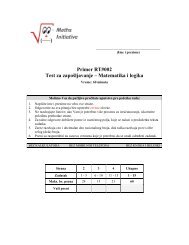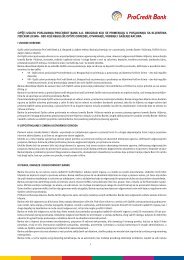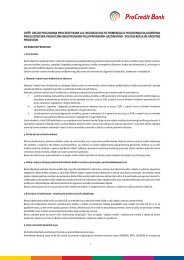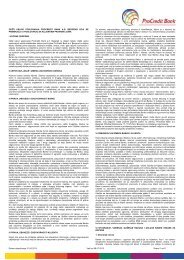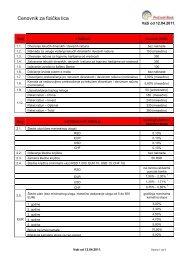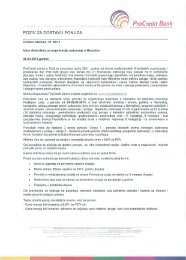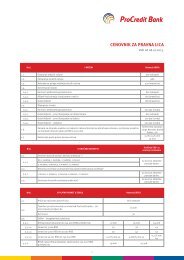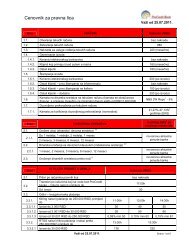Annual Report 2010 - ProCredit Bank
Annual Report 2010 - ProCredit Bank
Annual Report 2010 - ProCredit Bank
- No tags were found...
You also want an ePaper? Increase the reach of your titles
YUMPU automatically turns print PDFs into web optimized ePapers that Google loves.
Risk Management 25<br />
In <strong>2010</strong> the bank introduced the group-wide New<br />
Risk Approval (NRA) process, which is applied to<br />
all materially new or changed products, services<br />
or business processes. Only after the elimination<br />
of any obstacles or deficiencies revealed by<br />
the NRA process does management give its approval<br />
for the innovation to go ahead.<br />
The bank’s Business Continuity Policy ensures<br />
that the bank can maintain or restore its operations<br />
in a timely manner in the event of a serious<br />
disruption. As well as defining the steps to be<br />
taken to restore normal operations, the bank’s<br />
Business Continuity Plan specifies the procedure<br />
for moving critical operations to temporary locations,<br />
the resources that need to be mobilised<br />
in each type of case and the expected cost of<br />
disruptions in specific areas. It also offers guidance<br />
on avoiding disruption in the first place.<br />
<strong>ProCredit</strong> <strong>Bank</strong> Serbia has a rigorous three-part<br />
Business Continuity Plan that addresses general<br />
emergency situations, power failures and IT system<br />
integrity.<br />
Fraud has been recognised as the most significant<br />
source of operational risk, especially<br />
in the context of lending operations. To offset<br />
this risk, the bank has established clearly defined<br />
procedures and control mechanisms for<br />
loan approval, disbursement and monitoring.<br />
In addition, a dedicated fraud prevention team<br />
has been set up to address all fraud cases and<br />
propose countermeasures. The bank has since<br />
introduced a system for anonymous reporting of<br />
incidents and training courses aimed at raising<br />
fraud awareness.<br />
Anti-Money Laundering<br />
<strong>ProCredit</strong> <strong>Bank</strong> Serbia fully endorses the fight<br />
against money laundering and terrorist financing,<br />
and has implemented the Group Anti-Money<br />
Laundering Policy, which meets the requirements<br />
of Serbian, German and EU legislation. No<br />
customer is accepted and no transaction is executed<br />
unless the bank understands and agrees<br />
to the underlying purpose of the business relationship.<br />
The Group Anti-Money Laundering Department<br />
(Group AML) conducts an annual survey<br />
of all <strong>ProCredit</strong> banks and updates the policy<br />
accordingly. In addition, all <strong>ProCredit</strong> banks submit<br />
quarterly reports on their AML activities to<br />
Group AML.<br />
At <strong>ProCredit</strong> <strong>Bank</strong> Serbia, responsibility for AML<br />
activities is exercised by the Compliance and<br />
AML Unit, employing one compliance officer, two<br />
AML specialists and a unit supervisor. The Unit<br />
prepares daily reports on all cash transactions<br />
exceeding EUR 15,000. In addition, any attempt<br />
to execute a transaction that arouses suspicion<br />
of money laundering, terrorist financing or some<br />
other criminal activity must be reported, regardless<br />
of the amount. Front-office staff receive intensive<br />
training in how to recognise suspicious<br />
transactions. In cases of doubt, Group AML<br />
takes the final decision on how to handle the<br />
suspicious transactions and suspicious customers<br />
reported by the bank. In the near future, the<br />
bank plans to automate its AML screening process:<br />
the AML, Embargo and PEP modules of the<br />
specialist software package Siron are scheduled<br />
to be installed in the first quarter of 2011.<br />
Capital Adequacy<br />
The bank’s capital adequacy is calculated on<br />
a monthly basis and reported both to the management<br />
and to the Group Risk Management<br />
Committee, together with rolling forecasts to<br />
ensure future compliance with capital adequacy<br />
requirements. Strong support from our shareholders<br />
once again enabled the bank to maintain<br />
a comfortable capital cushion. At year-end<br />
<strong>2010</strong> the capital adequacy ratio (tier 1 and tier 2<br />
capital / risk-weighted assets) stood at 14.4%,<br />
well above the group-wide target of 12%. Capital<br />
adequacy according to local regulations was<br />
17.45%, which is also significantly above the locally<br />
required minimum of 12%.<br />
<strong>ProCredit</strong> <strong>Bank</strong>’s ratings, issued by FitchRatings,<br />
remained unchanged in <strong>2010</strong>. For foreign<br />
currency credit, its long-term Issuer Default Rating<br />
(IDR) was BB- and its short-term IDR was B;<br />
for local currency, its long-term and short-term<br />
ratings were BB and B, respectively.



